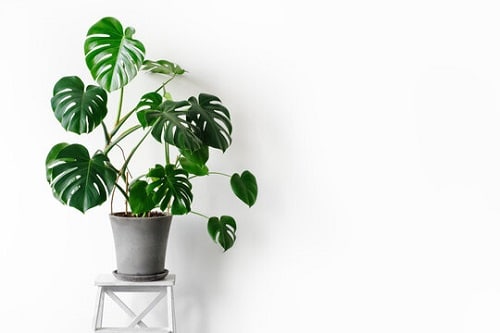Split-leaf Philodendron Care is easy if you do it in the right way. Learn the process in detail and grow this lush plant at home!
With awesome large and lush green leaves, the monstera looks simply fabulous in any type of decor. If you want to maintain it without a fuss, then learn everything about Split-leaf Philodendron Care here.
Split-leaf Philodendron

Also known as the Swiss cheese plant or monstera deliciosa, this popular low-maintenance houseplant is native to Panama, India, and the jungles of Mexico. It features glossy heart-shaped and split foliage. The splits on the foliage are called cuts.
Propagation
From Stem Cutting
- Find the node
Look for the brown circular rings on the stem from where new foliage and roots will emerge. Take 4-6 inches of a long stem with 2-3 nodes. It will give a great chance of success.
- Cutting the Stem
Take clean, sharp pruning shears or scissors and snip the stem with several nodes or leaves. Wash the cutting and remove the extra bottom leaves–two or three leaves would be fine. Allow the cutting to sit overnight before planting.
- Select a Growing Medium
Monstera deliciosa can be grown in water or soil. Water as a growing medium is much better as it helps in checking the root and progress.
- Location
Keep the cuttings in a warm, bright location. If you are growing it in soil, maintain the moisture with regular watering. Whereas if growing in water, change it regularly.
When you notice new growth, pot it in a suitable container.
Propagating Monstera in Water
You can also grow the plant easily in water without worrying about soil! We have a great article with all the information you need to grow it in vases and jars in water. Check it out here.
Requirements for Growing Monstera Deliciosa

Light
Monstera deliciosa prefers medium to bright light. It can withstand low light too, but the leaves will not split. Avoid placing the plant in direct sunlight for long durations.
Soil
Use rich, well-draining soil with a good amount of peat moss. It will keep the plant happy, helping it thrive for a long time to come.
Watering
Water the plant deeply until it comes out from the bottom holes. Allow the topsoil to dry before watering again. Maintain the soil moisture but do not allow it to become soggy.
Fertilizer
Feed it with a balanced liquid plant food, once a month, during its spring and summer growing period. For dosage, refer to the label.
Temperature
Split-leaf philodendron does well in warm temperatures between 68–86 °F (20-30 °C). If you have a humid room, it will do wonders for the growth of the plant.
Split-Leaf Philodendron Care

Pests and Diseases
Monstera deliciosa is resistant to pests, but if you notice any aphids, mealybugs, spider mites, or scales, spray them away using a mixture of alcohol, water, mineral oil, and biodegradable liquid soap.
Examine the bacterial diseases like leaf tip burn, Erwinia Blight, and Xanthomonas leaf spot, particularly in humid environments.
Pruning
You have to trim monstera deliciosa attentively, or it will cover your entire room! Also, keep the large foliage clean by wiping it with a soft, damp cloth, once every 3-5 weeks.
Toxicity
Keep your potted monstera deliciosa out of reach from pets and kids, as this plant is toxic because of the calcium oxalate crystals. If consumed in large quantities, it can cause irritation in the mouth, throat, and tongue, nausea, vomiting, and diarrhea.



Monstera Deliciosa and Split-Leaf Philodendron are NOT the same thing and a google search will show that the leaves are very different from one another. Unfortunately many websites, like this one, have mixed the two names up leading people to believe they are one and the same plant. Even greenhouses mix up the names. Split-Leafs are more jaggedy and have deep lobes going from edge of leaf into deep splits. Monsteras are climbing vines and in natural habitat climb up trees so they need support. Philodendrons are bushes and they have a trunk and do not need support. Be very careful and do your research when buying these plants as it seems the professionals and greenhouses don’t even know what to call them.